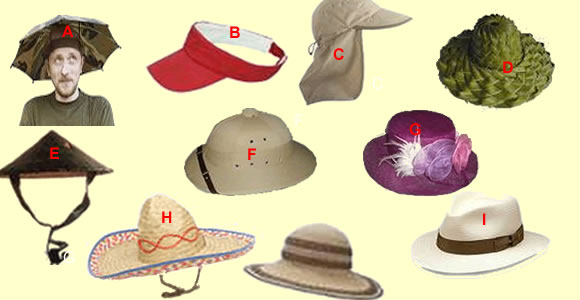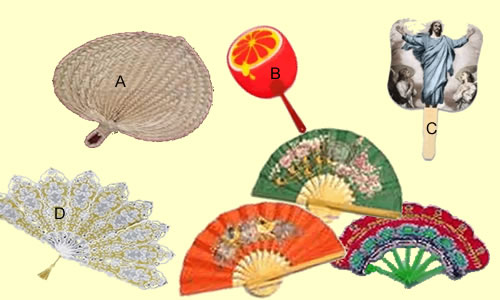|
It has presumably a deeper reason maybe not fully recognized if the sun-symbol appears also in the flag of the Philippines. The country is not only - as Rizal emphasised it in his farewell-poem Mi Ultimo Adios, carresed by the sun. The sun can also burn as hotly as a gigantic iron. Precautions have to be taken against the negative consequences of a sweltering sun. Here some incomplete remarks about sun protection in the Philippines and how people deal with hot, standing air. Sunshades First of all we have to mention umbrellas. While in northern countries they are mostly used as shelter against showers of rain, umbrellas in the Philippines have primarily to serve as a protection against the sun. Especially the Philippine ladies favour a bright skin and don't like to be brown as a construction or street worker. is not very beneficial to the social status to have a brown skin. An umbrella loses, however, its raison d´ être at a tropical storm or a typhoon. When it comes to an unhappy turn or crosswinds there is always a danger, that the umbrella turns its inside outside. Several sunshades can be found even in poorer households in the Philippines: Big ones, under which also two persons can find a place or smaller, more handy ones, such with short or long handle. And mostly you will find also in a corner of the house umbrellas with broken braces or ruptured cover. The colours can show all colour spectra of the kaleidoscope although brighter colours are recommended because of better sun reflection. The question which colour a beautiful should have can preoccupy women for hours: beige and pale green, or yellow and blue, red orange and yellow or yet beige and pale green? A clever man should retire during such consultations. Sunshades do not only offer protection against a strong solar radiation. Longer versions can also serve as a walking stick. It is possible to poke with them in garbage them or to draw something quickly in the sand. If the umbrella also has a metal tip, then it is good as a beating or stabbing weapon, too. The martial arts of Escrima or Arnis are also using umbrellas as weapon. Particularly young women appreciate this usage because in a situation of fear and trembling it is sometimes very difficult to find the pepper spray or other aids in the bag. However, usage as a weapon is more ultimo ratio. Certainly a graceful Payong dance of young Filipina with gloriously colourful sunshades shows a more peaceful picture. At nightfall it might be difficult to discover the ubiquitous holes, craters, edges, demolitions and other obstacles on Philippine pavements. No distress for you , if you have a shade with an integrated flashlight. A sunshade is also good to get in contact. Maybe you have taken into sight a young lady without sunshade on a hot day. Perhaps you could try it with the following offer: Haika. Sukob na ("Come here - share my umbrella"). Maybe you have no umbrella, but the girl has one. Then you could ask her a little bit boldly: Pwedeng maki sukob? ("May I share your umbrella")? We wish you good luck. Of course the constant risk of a loss in the supermarket, in the Jeepney or in the bank is also given also in the Philippines. It is a question of precaution whether the loss can be delimited to only one umbrella per annum. Sunshades have also their price and a cost-free one with advertising label and advertising logo is sometimes difficult to get. In recent past umbrellas with slogans were also used as instruments of propaganda for example in favour for "breast-feeding". We hope that you will not loose just this decorative umbrella which you have perhaps purchased for a lot of money on an auction of Philippine artists. Sometimes it is difficult to walk on the pavements in thick passer-by traffic with a bigger umbrella. Maybe that your politeness is challenged: You go ahead "," After you, please or "No, you first" are in this case standard phrases. Collisions are not absent. You may also become in spite of all manoeuvres the victim of a giant puddle if it is darker and your umbrella is near you face. Therefore some prefer a (partly) transparent umbrella to get a better view of the environment. In changeable weather there are - besides the many mixed types - two types of people who, generally, do not trust the weather an inch. My Philippine wife belongs to type I. Only if there is a little cloud on the sky here in "Old Germany, she grasps her umbrella as if she wants to provoke a fall of rain. Type II is fundamentally more resigned. Persons of this classification know, that when they take their umbrella along, the sun will laugh from the sky. If they don´t take an umbrella, however, then it will rain. In view of such unavoidable misjudgements they refuse to take an umbrella anyhow. Hats and headgears Umbrellas have the unpleasant feature that they have to be hold with one hand. An umbrella hat (A) could be the suitable in case of work with two hands. And with that remark headgears and hats become an issue. Among headgears we have a wide selection and our gallery can only present some few;
The choice begins at the headscarves, frequently worn by fishermen and continues with cheap plastic-caps with and without headgear or advertising label (B, C with neck guard). Caps without a circulating brim, such as the well-known beret, offer hardly a protection against the sun. A person who wants to show solidarity in a very special way with the farmers of South East Asia countries, select perhaps a rice straw hat (E), which changes very quickly in a brownish colour or the conical bamboo hat with chin strap. Whoever has not yet put aside colonial or imperial attitudes will perhaps decide for in favour of a pith-helmet (F). However, in the Philippines he should not take the Japanese war model. Aunty Esmeralda thinks that the Daisy hat (G) suits her. A sombrero hat (H) will also serve well. Former president Honnecker of German Democratic Republic had a preference for Panama hats (I) when he travelled to the tropics. Panama hats can be expensive because of the elaborate processing. Straw hats manufactured from the Abaca plant, the Talipot palm, rice or Toquilla straw - can be recommended generally because they are pervious to air and offer an adequate protection against rain. We still have to wait for a hat with a built-in air conditioner.
Hand fans In the Philippines people suffer very often from a stagnant hot humid air and they would give a kingdom for a fresh, cool wind breeze. Such one enjoying an air condition or electrical ventilator can consider himself lucky. But they are not on each place available. Then each broader, flat surface like a folded newspaper can be helpful. However, it is questionable if a folded newspaper produces so much fresh air like a better fan. Fans have an ancient historical tradition. Already the old Egyptians fanned out their rulers fresh air with giant fans. The Chinese also can look back on a long fan-tradition. They developed many types fan with partly sophisticated technology and beautiful decorations. In Europe the fan had its prime time particularly in the Rococo period. It was an indispensable equipment for the aristocratic ladies of this time. Today hand fans are in the northern countries "out of fashion". If we see it right, only the fashion monger Karl Lagerfeld tries to give his hollow words more importance by waving a hand fan. The situation in the Philippines is very different. Hand fans, sometimes also called abanikos can be found like brooms almost in every household. It is also used by men. The following picture shows some of the fans, which can be found on the Philippines:
Everywhere in the province the simple fan type (A) can be found. Mostly it is manufactured from the Buri palm. The lollypop fan (B) fits in the modern advertising world. Fan (C) is for church-goers and should demonstrate faith and devoutness to the public. Type D shows a more decorative fan. Decorative fans are more than a utensil, they are also status symbol. Sheets can be from paper, silk, leather (even swan skin) and are sometimes embroidered with shimmering sequins and painted with flower motives. The outer deck rods, which protect the fan, can also be decorated. Expensive noble variants show occasionally a rack of tortoiseshell, horn, mother-of-pearl or ivory and perhaps a precious stone adorns the thorn. Sometimes you can see young women dancers in the Philippines holding in their hands castanets and hand fans. Thanks to Jose Rizal the fan has also got a certain cultural meaning. Maria Clara one his main characters in the novel Noli me tangere " and for a long time the woman idol in the Philippines was also a owner of a precious hand fan. Lets quote Jose Rizal briefly: .... she showed her love with that maiden modesty which, having never been conscious of any but pure thoughts, knows not the meaning of false blushes. While she would cover her face with a fan when she was teased, still her eyes smiled over the fan.... All gazed in ecstasy at the beauty of Maria Clara and some old women murmured, as they chewed their buyo, She looks like the Virgin! (1). With her fan Maria Clara expresses a certain embarrassment. There shall be also a fan language in the Philippines. If the chin is covered with a fan, then this shall be an expression of the modesty while quick fan movements signal uneasiness. We do not know whether the fan language, a kind of secret language in more regulated societies, has reached in the Philippines this differentiation and stage of development which it had particularly in the Europe of the 18th century. Fan at the left ear for example signalled at that time Stop bothering me", the gliding of the fan over the cheek was a coquettish form of expression for "I love you" and a fan lying on the lip expressed a request for a kiss. Perhaps you simply try out, whether particularly the latter two fan gestures still function. May be that your partner is ignorant about the meaning of the gesture or he does not want to understand it. May be you are the cause. It only can become worse if your partner in view of your inviting gestures should react with an Abaniko stroke known from the martial art of Eskrima. With an Abaniko stroke the opponent is getting - like a fan - less hard but very fast and precise blows on different parts of body. Please don't fall. © Wolfgang Bethge in 2007 (1) retranslated from the German version: Jose Rizal, Noli Me tangere, Darmstadt, 2000, p. 188 |


